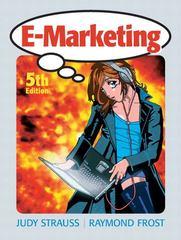Question
1. Consider the generic game below. Find the Nash Equilibrium by taking these steps: For each action which could be taken by player B, circle
1. Consider the generic game below. Find the Nash Equilibrium by taking these steps:
- For each action which could be taken by player B, circle the best payout(s) player A has in that column. These are player A's "best responses".
- For each action which could be taken by player A, circle the best payout(s) player B has in that row. These are player B's "best responses".
- Any outcome for which both A's payout and B's payout are circled is a Nash Equilibrium.
Player B | |||||
Player A | Up | Down | Left | Right | |
North | 2 for A 35 for B | 5 for A 20 for B | 8 for A 10 for B | 6 for A 16 for B | |
South | 4 for A 13 for B | 4 for A 17 for B | 10 for A 15 for B | 6 for A 18 for B | |
East | 4 for A 15 for B | 3 for A 10 for B | 9 for A 40 for B | 3 for A 20 for B | |
West | 6 for A 20 for B | 2 for A 20 for B | 6 for A 12 for B | 0 for A 50 for B |
How many Nash equilibria are there? ___________
Pick a Nash equilibrium you found. In that Nash equilibrium, Player A plays ________ and Player B plays _________ .
2. Explain why we'd expect steps 1-3 in the previous question to give us a Nash Equilibrium.
3. You have just graduated and are planning to move away from Colorado at the end of next month, and your landlord knows it. Your landlord is deciding whether or not to raise your rent for your last month. After you see whether your landlord has decided to raise your rent or not, you can choose to stay in your apartment, or move to another apartment for one month before you leave Seattle (which is expensive!). If your landlord raises your rent and you stay in your apartment, your landlord gets 100 utility and you get 50. If your landlord doesn't raise your rent and you stay, your landlord gets 75 utility and you get 100. If you decide to leave, your landlord gets 0 utility and you get 25, whether or not the landlord raised the rent.
Draw the game tree for this game. Remember that the landlord chooses first, and then you choose.
4. In this game, there are two players, the "proposer" and the "receiver." Imagine the proposer has been given $10. The proposer decides how much to keep for themselves, and how much to give to the receiver (for example, the proposer may choose to keep $7 and give the receiver $3). The receiver may then accept the split, in which case both players get the amount of money the proposer suggested, or reject the split, in which case neither player gets any money. Pretend that both of you only care about money.
If you play this game once and you can only do whole-dollar splits (i.e. you can't propose $5.50/$4.50), how much money does the proposer offer the receiver in the Nash equilibrium?
Step by Step Solution
There are 3 Steps involved in it
Step: 1

Get Instant Access to Expert-Tailored Solutions
See step-by-step solutions with expert insights and AI powered tools for academic success
Step: 2

Step: 3

Ace Your Homework with AI
Get the answers you need in no time with our AI-driven, step-by-step assistance
Get Started


